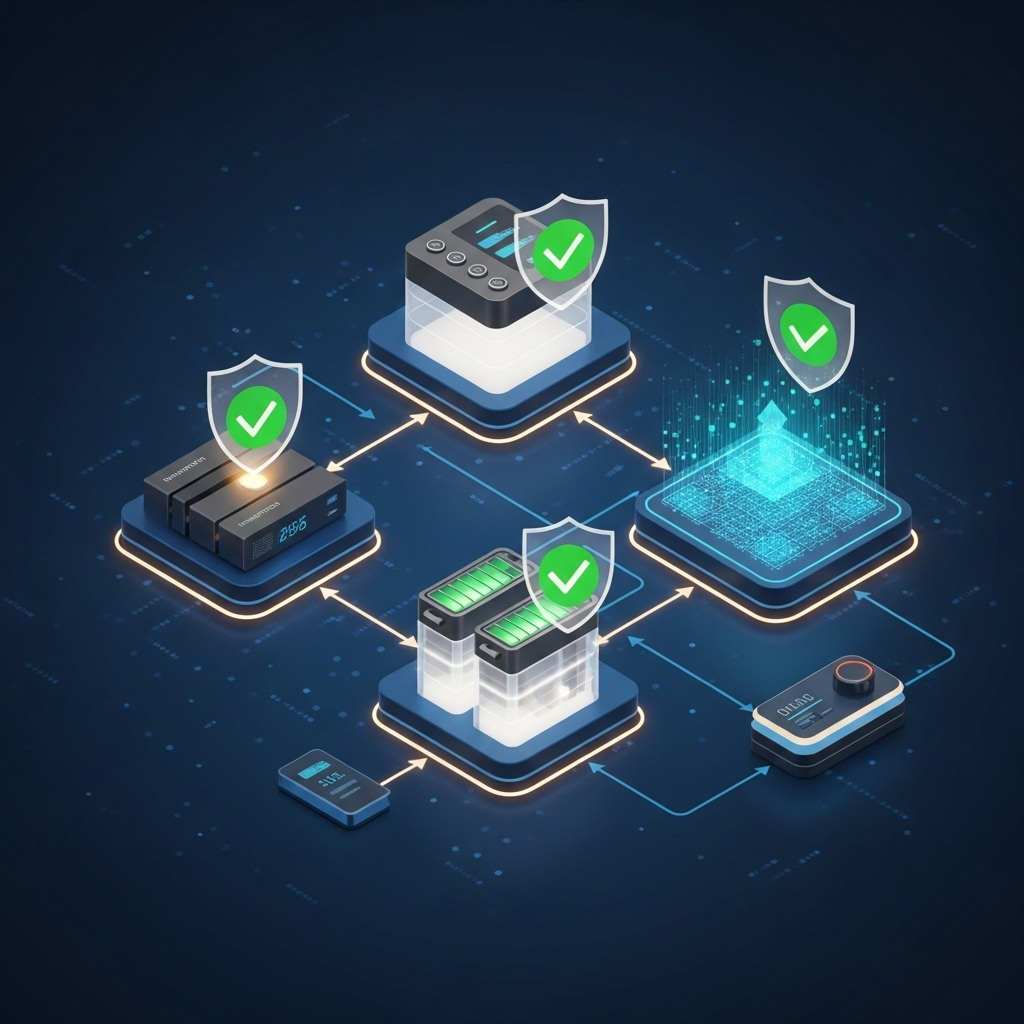Hybrid inverters are central to modern solar and energy storage systems, intelligently managing power flow between solar panels, batteries, and the electrical grid. As more renewable energy sources connect to the grid, maintaining its stability is paramount. This is where grid code compliance becomes a critical topic. Adhering to these technical rules is not just a regulatory hurdle; it is essential for the safe and efficient operation of the entire energy infrastructure. Effectively monitoring your hybrid inverter is the key to ensuring it consistently meets these demanding standards.
Understanding Grid Code Compliance for Hybrid Inverters
Grid code compliance involves a set of technical specifications that any power-generating unit, including a solar energy system with a hybrid inverter, must meet to connect to the electricity grid. These rules govern how the system behaves and interacts with the grid to ensure reliability and safety for all users.
What Are Grid Codes?
Grid codes are the technical rulebook for the electrical grid. They define the required performance of systems connected to it, covering critical parameters like voltage and frequency operating ranges, fault ride-through capabilities, and power quality. For hybrid inverters, this includes controlling harmonic distortion, which are non-integer multiples of the fundamental frequency that can disrupt grid stability. According to the International Renewable Energy Agency's report, Grid Codes for Renewable Powered Systems, standards like IEEE 519 provide essential guidelines for managing the harmonics produced by grid-tied inverters.
Why Compliance is Non-Negotiable
A non-compliant inverter can act as a disruptive element on the grid. It might fail to support the grid during a voltage dip, inject disruptive electrical noise (harmonics), or disconnect unexpectedly, potentially triggering wider grid instability. The consequences range from warnings and financial penalties from the utility to forced disconnection. For the system owner, this translates to lost energy production and a poor return on investment. For the grid, widespread non-compliance threatens the reliability of the power supply for everyone.
Evolving Standards and System Adaptability
Grid codes are not static. As the energy landscape evolves with higher penetrations of renewable sources, these regulations are frequently updated to address new challenges. This dynamism requires that modern hybrid inverters are not just compliant at the time of installation but are also adaptable. The ability to receive firmware updates is crucial for adjusting an inverter's operational parameters to meet new or revised grid requirements without needing a physical replacement.
The Core Role of Remote Monitoring
Continuous remote monitoring is the foundation of a successful grid code compliance strategy. It transforms compliance from a passive, one-time check into an active, ongoing process. By collecting and analyzing real-time operational data, you can ensure your system is performing as expected and take corrective action before a problem arises.

Real-Time Data for Proactive Management
An effective inverter monitoring solution provides a constant stream of data about your system's interaction with the grid. This includes second-by-second measurements of voltage, frequency, real and reactive power, and power quality. This visibility allows operators to detect subtle deviations that could indicate a developing issue. For example, a gradual increase in harmonic distortion might signal a component issue that needs attention before it breaches compliance limits. This proactive approach prevents costly downtime and potential penalties.
Key Performance Indicators (KPIs) to Track
Monitoring for grid code compliance involves tracking several specific KPIs. While the exact limits vary by region and utility, the core parameters are universal. Below is a table outlining some of the most critical KPIs for a hybrid inverter.
| KPI | Typical Acceptable Range | Risk of Deviation |
|---|---|---|
| Grid Voltage | Nominal voltage ±5-10% | Risk of disconnection, damage to connected appliances. |
| Grid Frequency | Nominal frequency ±0.5-1% | System instability, potential for cascading grid failure. |
| Power Factor | > 0.95 (leading or lagging) | Inefficient power transmission, potential utility penalties. |
| Total Harmonic Distortion (THD) | < 5% | Equipment overheating, interference with other electronics. |
| Fault Ride-Through | Remain connected during specified voltage/frequency dips | Unexpected system shutdown, contributing to grid instability. |
Automated Alerts and Reporting
Modern monitoring platforms do more than just display data. They incorporate sophisticated alert systems that automatically notify you or your service provider when a KPI moves outside its predefined compliance window. This immediate notification enables a rapid response to correct the issue. Furthermore, these platforms can generate historical performance reports, which are often required by utilities to demonstrate ongoing grid code compliance, simplifying the administrative burden on system owners.
Firmware Updates: The Key to Adaptability
If remote monitoring is how you watch for problems, firmware updates are how you fix many of them. Firmware is the software embedded in the inverter that controls its core functions. Secure and reliable updates are essential for adapting to new challenges and maintaining compliance over the life of the system.
Adapting to Changing Grid Requirements
As utilities update their grid codes, an inverter's behavior may need to change. A firmware update can adjust voltage thresholds, modify frequency response curves, or improve power quality algorithms. A report from the International Energy Agency, Next Generation Wind and Solar Power, highlights that unlocking the full potential of solar power requires inverters to be 'technically capable and correctly programmed.' Firmware updates are the primary mechanism for ensuring they remain correctly programmed throughout their operational life.
The Mechanics of a Secure Firmware Update
Delivering updates securely is critical. Over-the-Air (OTA) updates are a common method, allowing manufacturers to deploy new firmware remotely without a costly site visit. To prevent unauthorized or malicious code from being installed, these updates must be digitally signed and verified. Some high-security systems even use hardware like data diodes, which permit data to flow in only one direction, to send monitoring data out while physically blocking any incoming signals, as noted in a U.S. Department of Energy success story on protecting solar plants from cyber threats.
Linking Performance Monitoring to Firmware Needs
The relationship between monitoring and firmware is a continuous feedback loop. Monitoring data provides the context for compliance, helping to identify where the inverter's performance can be improved. A comprehensive understanding of your system's capabilities is foundational. Mastering concepts explained in resources like the Ultimate Reference for Solar Storage Performance helps you interpret this data effectively. When monitoring reveals a deviation or a new grid code is announced, a targeted firmware update can be developed and deployed to close the gap, ensuring the system remains fully compliant and performs optimally.
Building a Robust Compliance Strategy
Achieving and maintaining grid code compliance requires a holistic strategy that combines initial testing, continuous monitoring, and a secure infrastructure. This approach ensures your renewable energy asset is both a good citizen on the grid and a reliable source of power for you.
Combining Testing and Continuous Monitoring
A robust strategy doesn't rely on a single method. The International Renewable Energy Agency suggests that compliance is best achieved when all available strategies are combined. This includes type tests during development, on-site commissioning tests at installation, and continuous in-operation monitoring. This layered approach verifies compliance at every stage of the project's lifecycle, from design to daily operation.
The Importance of a Secure Monitoring Infrastructure
As energy systems become more interconnected, their vulnerability to cyber threats increases. A secure monitoring infrastructure is essential. This involves more than just password protection. Advanced strategies include multi-layered energy management systems and the use of grid-forming inverters, which can autonomously help restore power after an outage. A project highlighted by the U.S. Department of Energy demonstrated how grid-forming inverters could successfully restart a simulated grid, showcasing their power to enhance resilience.
Choosing the Right Inverter Monitoring Solution
When selecting a hybrid inverter, evaluate its monitoring capabilities carefully. Look for a solution that offers high-granularity data, robust security protocols, an intuitive user interface, and seamless support for remote firmware updates. The quality of the monitoring platform is as important as the hardware itself for ensuring long-term performance and compliance.
Final Thoughts: Proactive Management for Future-Proof Assets
Grid code compliance is not a set-it-and-forget-it task. It is an ongoing commitment that is vital for the health of the electrical grid and the performance of your solar investment. By pairing advanced remote monitoring with a secure and agile firmware update strategy, you can proactively manage your hybrid inverter. This approach ensures your system not only meets today's standards but is also ready to adapt to the requirements of tomorrow's smarter, more resilient energy grid.
Frequently Asked Questions
What happens if my hybrid inverter is not grid code compliant?
Non-compliance can lead to disconnection from the grid, fines, and potential safety hazards. It can also contribute to grid instability, affecting the wider community. Utilities have the authority to enforce compliance to protect the integrity of the power supply.
How often do grid codes change?
Grid codes are updated periodically by regional transmission organizations or utility commissions to adapt to new technologies and changing grid conditions. The frequency varies by jurisdiction, but you should expect revisions every few years as more renewable resources are integrated.
Can I monitor my inverter's compliance myself?
Many modern hybrid inverters come with monitoring platforms (apps or web portals) that provide access to key performance data. While you can observe metrics like voltage and frequency, a comprehensive compliance assessment often requires specialized tools and expertise from your installer or service provider to interpret the data correctly and verify adherence to specific local codes.





Leave a comment
All comments are moderated before being published.
This site is protected by hCaptcha and the hCaptcha Privacy Policy and Terms of Service apply.